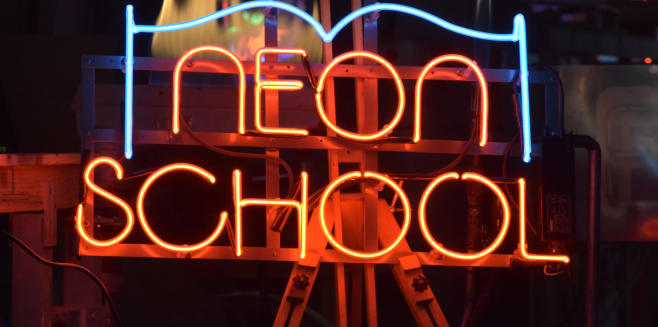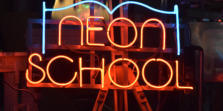History of Neon Signs
The neon sign is an evolution of the earlier Geissler tube, which is an electrified glass tube
containing
a "rarefied" gas (the gas pressure in the tube is well below atmospheric pressure). When a voltage is applied to
the electrodes inserted through the glass, an electrical glow discharge results. Geissler tubes were quite popular
in the late 1800s, and the different colors they emitted were characteristics of the gases within. They were, however,
unsuitable for general lighting; the pressure of the gas insidetypically declined in use. The direct predecessor of
neon tube lighting was the Moore tube, which used nitrogen or carbon dioxide as the luminous gas and a patented
mechanism for maintaining pressure; Moore tubes were sold for commercial lighting for a number of years in the
early 1900s.
The discovery of neon in 1898 included the observation of a brilliant red glow in Geissler tubes. Immediately
following neon's discovery, neon tubes were used as scientific instruments and novelties. A sign created by
Perley G. Nutting and displaying the word "neon" may have been shown at the Louisiana Purchase Exposition
of 1904, although this claim has been disputed;in any event, the scarcity of neon would have precluded the
development of a lighting product. However, after 1902, Georges Claude's company in France, Air Liquide,
began producing industrial quantities of neon, essentially as a byproduct of their air liquefaction business. From
December 3–18, 1910, Claude demonstrated two 12-metre (39 ft) long bright red neon tubes at the Paris Motor
Show. This demonstration lit a peristyle of the Grand Palais (a large exhibition hall).Claude's associate, Jacques
Fonseque, realized the possibilities for a business based on signage and advertising. By 1913 a large sign for the
vermouth Cinzano illuminated the night sky in Paris, and by 1919
the entrance to the Paris Opera was adorned with neon tube lighting.Over the next several years, patents were
granted to Claude for two innovations still used today: a "bombardment" technique to remove impurities from the
working gas of a sealed sign, and a design for the internal electrodes of the sign that prevented their degradation
by sputtering.
In 1923, Georges Claude and his French company Claude Neon introduced neon gas signs to the United States
by selling two to a Packard car dealership in Los Angeles. Earle C. Anthony purchased the two signs reading
"Packard" for $1,250 apiece.Neon lighting quickly became a popular fixture in outdoor advertising. Visible even
in daylight, people would stop and stare at the first neon signs for hours, dubbed "liquid fire.”
The next major technological innovation in neon lighting and signs was the development of fluorescent tube
coatings. Jacques Risler received a French patent in 1926 for these.[3] Neon signs that use an argon/mercury
gas mixture emit a good deal of ultraviolet light. When this light is absorbed by a fluorescent coating, preferably i
nside the tube, the coating (called a "phosphor") glows with its own color. While only a few colors were initially
available to sign designers, after the Second World War (1939–1945) phosphor materials were researched
intensively for use in color televisions. About two dozen colors were available to neon sign designers in the 1960s,
and today there are nearly 100 available colors.


History of Neon Signs
The neon sign is an evolution of the earlier Geissler tube, which is an
electrified glass tube containing a "rarefied" gas (the gas pressure in the tube is well
below atmospheric pressure). When a voltage is applied to
the electrodes inserted through the glass, an electrical glow discharge results.
Geissler tubes were quite popular in the late 1800s, and the different colors they
emitted were characteristics of the gases within. They were, however, unsuitable for
general lighting; the pressure of the gas insidetypically declined in use. The direct
predecessor of neon tube lighting was the Moore tube, which used nitrogen or
carbon dioxide as the luminous gas and a patented mechanism for maintaining
pressure; Moore tubes were sold for commercial lighting for a number of years in
the early 1900s.
The discovery of neon in 1898 included the observation of a brilliant red glow in
Geissler tubes. Immediately following neon's discovery, neon tubes were used as
scientific instruments and novelties. A sign created by Perley G. Nutting and
displaying the word "neon" may have been shown at the Louisiana Purchase
Expositionof 1904, although this claim has been disputed;in any event, the scarcity
of neon would have precluded the development of a lighting product. However, after
1902, Georges Claude's company in France, Air Liquide, began producing industrial
quantities of neon, essentially as a byproduct of their air liquefaction business. From
December 3–18, 1910, Claude demonstrated two 12-metre (39 ft) long bright red
neon tubes at the Paris Motor Show. This demonstration lit a peristyle of the Grand
Palais (a large exhibition hall).Claude's associate, Jacques Fonseque, realized the
possibilities for a business based on signage and advertising. By 1913 a large sign
for the vermouth Cinzano illuminated the night sky in Paris, and by 1919
the entrance to the Paris Opera was adorned with neon tube lighting.Over the next
several years, patents were granted to Claude for two innovations still used today: a
"bombardment" technique to remove impurities from the working gas of a sealed
sign, and a design for the internal electrodes of the sign that prevented their
degradation by sputtering.
In 1923, Georges Claude and his French company Claude Neon introduced neon
gas signs to the United States by selling two to a Packard car dealership in Los
Angeles. Earle C. Anthony purchased the two signs reading "Packard" for $1,250
apiece.Neon lighting quickly became a popular fixture in outdoor advertising. Visible
even in daylight, people would stop and stare at the first neon signs for hours,
dubbed "liquid fire.”
The next major technological innovation in neon lighting and signs was the
development of fluorescent tube coatings. Jacques Risler received a French patent
in 1926 for these.[3] Neon signs that use an argon/mercury gas mixture emit a good
deal of ultraviolet light. When this light is absorbed by a fluorescent coating,
preferably inside the tube, the coating (called a "phosphor") glows with its own
color. While only a few colors were initially available to sign designers, after the
Second World War (1939–1945) phosphor materials were researched
intensively for use in color televisions. About two dozen colors were available to
neon sign designers in the 1960s, and today there are nearly 100 available colors.
History of Neon Signs
The neon sign is an evolution of the earlier Geissler tube, which is an electrified glass tube
containing
a "rarefied" gas (the gas pressure in the tube is well below atmospheric pressure). When a voltage is applied to
the electrodes inserted through the glass, an electrical glow discharge results. Geissler tubes were quite popular
in the late 1800s, and the different colors they emitted were characteristics of the gases within. They were, however,
unsuitable for general lighting; the pressure of the gas insidetypically declined in use. The direct predecessor of
neon tube lighting was the Moore tube, which used nitrogen or carbon dioxide as the luminous gas and a patented
mechanism for maintaining pressure; Moore tubes were sold for commercial lighting for a number of years in the
early 1900s.
The discovery of neon in 1898 included the observation of a brilliant red glow in Geissler tubes. Immediately
following neon's discovery, neon tubes were used as scientific instruments and novelties. A sign created by
Perley G. Nutting and displaying the word "neon" may have been shown at the Louisiana Purchase Exposition
of 1904, although this claim has been disputed;in any event, the scarcity of neon would have precluded the
development of a lighting product. However, after 1902, Georges Claude's company in France, Air Liquide,
began producing industrial quantities of neon, essentially as a byproduct of their air liquefaction business. From
December 3–18, 1910, Claude demonstrated two 12-metre (39 ft) long bright red neon tubes at the Paris Motor
Show. This demonstration lit a peristyle of the Grand Palais (a large exhibition hall).Claude's associate, Jacques
Fonseque, realized the possibilities for a business based on signage and advertising. By 1913 a large sign for the
vermouth Cinzano illuminated the night sky in Paris, and by 1919
the entrance to the Paris Opera was adorned with neon tube lighting.Over the next several years, patents were
granted to Claude for two innovations still used today: a "bombardment" technique to remove impurities from the
working gas of a sealed sign, and a design for the internal electrodes of the sign that prevented their degradation
by sputtering.
In 1923, Georges Claude and his French company Claude Neon introduced neon gas signs to the United States
by selling two to a Packard car dealership in Los Angeles. Earle C. Anthony purchased the two signs reading
"Packard" for $1,250 apiece.Neon lighting quickly became a popular fixture in outdoor advertising. Visible even
in daylight, people would stop and stare at the first neon signs for hours, dubbed "liquid fire.”
The next major technological innovation in neon lighting and signs was the development of fluorescent tube
coatings. Jacques Risler received a French patent in 1926 for these.[3] Neon signs that use an argon/mercury
gas mixture emit a good deal of ultraviolet light. When this light is absorbed by a fluorescent coating, preferably i
nside the tube, the coating (called a "phosphor") glows with its own color. While only a few colors were initially
available to sign designers, after the Second World War (1939–1945) phosphor materials were researched
intensively for use in color televisions. About two dozen colors were available to neon sign designers in the 1960s,
and today there are nearly 100 available colors.

